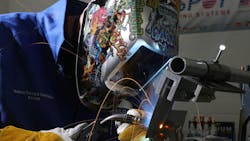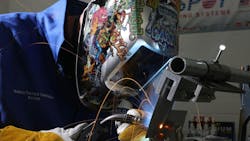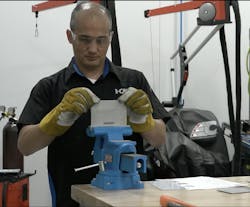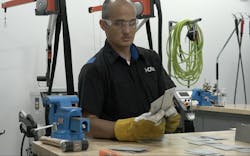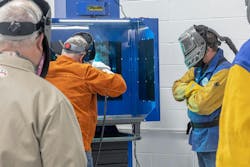Adding some certainty to certification
Alexander Graham Bell once declared, “Before anything else, preparation is the key to success.” That’s as true today as it was in your college and high school days and when you started your collision repair career. You were tested then, and you and your business continue to be tested now with the many training certifications necessary to compete in business and qualify for DRPs and manufacturer repair programs. All this testing can both wear on one’s nerves and tax your wallet when you worry whether staff will pass certification testing after you’ve paid for training.
The solution to this issue is adding some certainty to the certification equation. With proper preparation, you and your staff can pass even the most difficult testing. Use the following seven prep tips from I-CAR for their GMA Steel, Steel Sectioning and Aluminum Welding Certification (and recertification) programs. Consider using them as a model for prepping for your other certifications.
Tip 1. Accept that test prep is necessary.
Your welders are experienced and confident, so you may wonder if that shouldn’t be enough proof that they can sail through certification testing. The answer here is a resounding no. Brian Wasson, senior manager of core and specialty training for I-CAR, says being prepared is simply part of being a professional. You never want to walk into any important situation without having a good idea of what’s going to happen and what the expectations are. Further, shops need to step up and encourage test preparation. “Preparation is part of being successful, and you want to set up your welders for success,” Wasson says.
“I always put it in terms of painting because everyone in our biz recognizes a good paint job versus a bad paint job, and the differences between a good paint job and a bad paint job is the preparation,” he says. “If I do a really good job on the preparation, get that foundation, do my prep right with the paint job, the paint job's going to turn out great.”
I-CAR recommends experienced welders spend 1-2 weeks preparing while less experienced workers use 30 days.
Tip 2. Be familiar with all parts of the testing.
I-CAR makes a point of providing as much information as possible about its certification processes. The website I-CAR.com/welding details what certification involves.
You should be familiar with the fundamentals. First, there are separate certification processes for steel and aluminum. For those wanting their first certification, the GMA steel certification process lasts roughly 4 hours with some of that time being spent on testing while aluminum takes 6 hours, with the first four hours devoted to training (though each can take less time based on student readiness). Steel Sectioning is more advanced and can take up to 8 hours. A good portion of time involves the I-CAR instructor mentoring students as they practice their welds. Then, students put their skills to the test without instructor interaction and create a variety of welds for the instructor to evaluate on 3” x 5” pieces of steel or aluminum or a rail designed for the steel sectioning certification.
Students must also pass online testing of their knowledge of welding theory before applying for certification testing. Actual certification testing is 100-percent hands-on since skills are being assessed.
Instructors don’t simply assess the surface aspect of the weld. The integrity of the weld is evaluated through destructive testing, which I-CAR refers to as the “bend and break.” The instructor bends the weld until it breaks off and then inspects where it breaks. “We want it to break, not in the weld itself, but on the material that it's welded to,” explains Wasson.
Instructors thus assess the overall structure of the weld – length, width, and any defects such as porosity – and then perform the destructive test to determine if the welder can receive I-CAR certification.
Welders seeking recertification aren’t required to go through the training, just the certification testing. Those welders who do not pass certification receive detailed instructions from the instructor on what areas they need to improve. These welders can take the certification testing again when the shop reschedules it.
There’s a chance a shop may not need all the time set aside for the certification. Wasson says this time can be used for further training, even advanced training, for welders.
Tip 3. Work with your I-CAR representative.
The certification process begins when the shop first contacts I-CAR to request certification testing (certification is conducted on-site at the shop). Wasson says I-CAR selects an instructor who reaches out to the shop to discuss what certification involves. That instructor remains available through the scheduled certification date. Wasson says the shop and its welders can reach out to the instructor with any questions or concerns they may have. “That's the main reason why when we give the instructor the assignment, we make that connection between instructor and shop,” Wasson notes. “We want to give that direct access so shops can ask direct questions to them.”
Additionally, these reps can point to I-CAR and other resources to address specific concerns. For example, Wasson says shops can be directed to help directly from the manufacturer of the specific welder they'll use during certification. Instructors tailor their help to the shop and what they need for preparation, Wasson says.
Tip 4. Use all I-CAR resources.
Speaking of I-CAR resources, many are available online 24/7 to assist welders. These include:
I-CAR Equipment and Facility Checklists: Lists equipment requirements to ensure training integrity and preparedness for welding certification.
The Industry Knowledge & Skills Protocol outlines the knowledge and skills necessary for a complete, safe, and quality repair organized by role.
The Welding Issue of Collision Reporter has a wealth of resources.
I-CAR's YouTube channel also features plenty of videos.
Also, I-CAR provides 3” x 5” pieces of steel and aluminum (it calls them coupons) for welders to practice on. These coupons are the same pieces students use during the actual certification so there aren’t any surprises. I-CAR recommends welders use the lessons they’ve already learned and put them to work every day as part of their work routines.
Tip 5. Make sure your equipment works.
Wasson says shops may schedule certifications for Saturdays to avoid any conflicts with production (though the I-CAR will work to schedule for a day and time that works best for a shop). For those shops using a Saturday, Wasson cautions them to check out their welding equipment earlier in the week. “We always ask shops to perform equipment checks since equipment is typically used on a regular basis by multiple people, so there’s a tendency to be in some state of disrepair. We usually recommend they contact their welding manufacturer to do the check, but the manufacturer may not be open on the weekend.”
Tip 6. Turn to your experienced welders for help.
One of your best certification-prepping tools is already under your roof – your experienced welders. Wasson recommends they work with your less-experienced staff to get them up to speed on skills and welding information. They can be particularly valuable if they’re already certified.
Tip 7. Get a handle on your nerves.
Even the most skilled and experienced welders can suffer from test anxiety or a simple case of the nerves. Some people just aren’t great at tests. If this is a potential issue at your shop, remind employees that they’re simply using the skills they’ve already prepared for and practiced. Good news; Wasson says I-CAR instructors come prepared to deal with test anxiety.
Keep in mind that the certification pass rate is 80 – 90 percent. I-CAR is looking to certify qualified collision repair workers and do what it can to prepare these folks to perform only top-quality work after the certification is complete.
You also can think of it this way. You work together with I-CAR to build in success with the right prep work before a test is ever taken, all for the ultimate benefit of the consumer per I-CAR’s vision.
About the Author

Tim Sramcik
Tim Sramcik began writing for ABRN over 20 years ago. He has produced numerous news, technical and feature articles covering virtually every aspect of the collision repair market. In 2004, the American Society of Business Publication Editors recognized his work with two awards. Sramcik also has written extensively for Motor Age and Aftermarket Business World. Connect with Sramcik on LinkedIn and see more of his work on Muck Rack.
